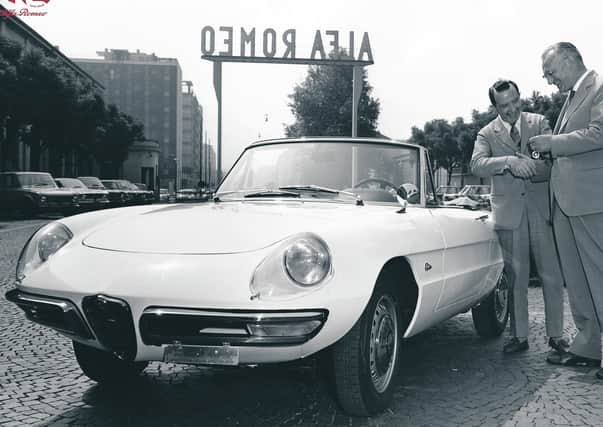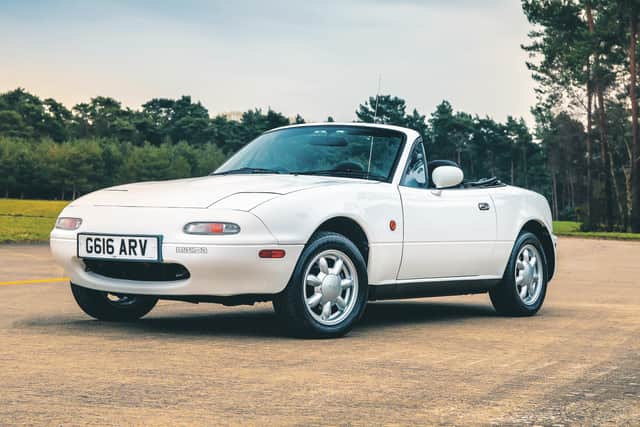Mazda and Alfa Romeo: Many happier returns


I’ve started shutting down on the horrors of Covid-19. Heck, I even switched off Andrew Marr on Sunday. There’s only so much I need to know about drives to Barnard Castle though for better times I can recommend the road there from Bampton through Middleton-in-Teesdale. I last did that route in an original Honda NSX – fabulous.
Mazda started as Toyo Kogyo, a 1920 establishment of a cork producing company in Hiroshima. In 1931 it made a motorbike trike with a carrying bed over the back wheels. It was called the Mazda-go. The name came from Ahura Mazda, the ancient Asian god of harmony, intelligence and wisdom.
Advertisement
Hide AdAdvertisement
Hide AdIn 1960 its first car was the R360, a very small two-door four-seater. Its utility vehicles continued and included the derived B360 pickup, which was a tidy carryall for light industry and farmers.


Practicality and purpose in Japan, beset by echoes of conflict, was more pressing than elegant prestige.
The later 20th century was a huge rush of success and refinement. Highlights included the Cosmo, a coupé with a rotary engine derived from that use by NSU in the Ro80. In 1991 a rotary engined racer became the first Japanese car to win the Le Mans 24-Hour race, a yardstick for the sport.
The rotary engine is much simpler than a conventional engine which has pistons pumping up and down in a block of cylinders and transfers power to the wheels through a massive crankshaft.
A rotary engine has a circular chamber with a triangular spinning piston inside. As the piston spins it collects fuel, compresses it for the spark ignition and then expels the waste gases in the third section of the cycle. The power is taken directly from the axis of the spinning piston.
These engines, in road cars like the RX-7, spun quickly to around 9,000 rpm, giving lots more power when turbocharged. For extra oomph a twin rotor set-up was used. They were compact, allowing low bonnets, reduced weight and driving excitement. However, there’s a big BUT. They used too much petrol and the rotor tips wore, allowing oil leakage, inefficiency and dirty emissions.
This didn’t matter for track racing in those days but for everyday road cars it was unsatisfactory, despite assurances at Press driving days that the problems were behind it. Not exactly… The rotary engine hasn’t been used since 2012 but is expected to be used in a hybrid capacity in next year’s MX-30 SUV.
For the modern generation Mazda is best-known for the MX-5, a light and lovely two-seater sports car which was inspired by British icons like the Lotus Elan and MGB. This type of car had faded but Mazda saw the gap for revival and when the MX-5 arrived in the 1990s it was an instant smash. The Americans probably appreciated the classic English roadster more than the British did. The MX-5 became the world’s highest selling sports car. With good reason: it was the classic front-engine, rear-wheel drive layout, with a stiff spine to connect the two ends.
Advertisement
Hide AdAdvertisement
Hide AdThe original had pop-up headlamps (viz the Triumph TR7 and Porsche 928). Subsequent models had fixed lights and a shape which evolved from softly gentle curves to the dramatic chiselled current car. This is a value alternative to something expensive and probably German. Importantly, it is great fun and relies on skill rather than colossal power to enjoy, err, a brisk drive.
The Mazda3 is an important model, and the reigning world car of the year, if such a title is possible. It has the company’s Skyactiv technology which uses large capacity engines with lean-burn combustion and eschews turbochargers. Like all modern Mazdas, it is very, very good to look at.
The Italians are the masters of beautiful cars. Ferrari, founded in 1947 and Maserati, from 1914, are exotic and exciting. Older than both is Alfa Romeo, another birthday celebrant at a valiant 110th.
The current Giulia is a classic rear-wheel-drive sports saloon. All three marques are part of Fiat, founded in 1899, making it one of the few surviving makers from the 19th century.
Alfa Romeo’s home is in Milan, regarded as Italy’s capital of fashion. The Villa d’Este on Lake Como is one of the world’s most desirable hotels and in 1949 Alfa Romeo and the coachbuilder Touring gave us the 6C Villa d’Este, which attracted the wealthy and influential and beautiful people of the era: Rita Hayworth, Evita Peron and Tyrone Power among them.
La Dolce Vita was on its way and cars like the Giulietta Spider of 1955 set the tune and tone and vibrant sexiness of the 1960s Italian cinema of Fellini and Antonioni and stars with names like Gina and Sophia and Marcello.
The Spider became known as the Duetto which Steve McQueen described as being very pretty and forgiving when he gave it a shake-down in 1966.
Dustin Hoffman was already hankering for a two-seater Alfa for leisure drives along America’s west coast. A decade on, and in his hands, in the 1967 film The Graduate, the Duetto became the most famous Italian car ever for the general public. Muhammad Ali was among many celebrity owners, number plate Ali Bee.
Comments
Want to join the conversation? Please or to comment on this article.